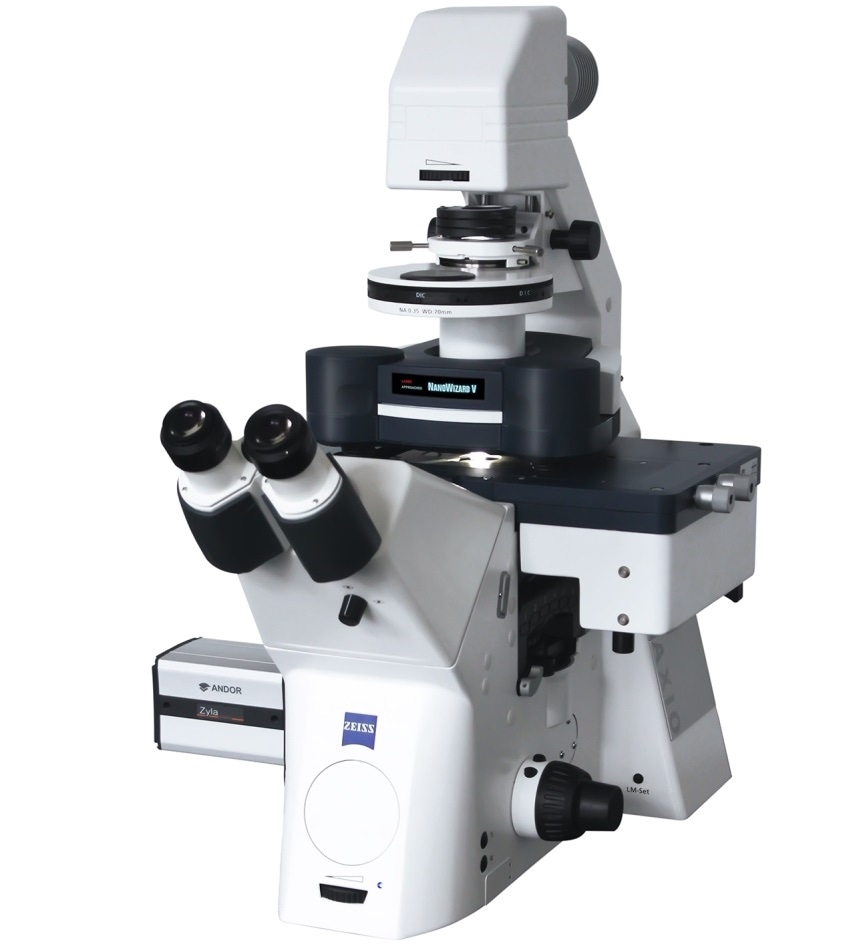Bruker today announced the release of the JPK NanoWizard® V BioAFM, a novel system that marks a milestone in automation and ease of use for life science atomic force microscopy research. NanoWizard V is a very fast, automated BioAFM that can optionally be fully integrated with advanced optical microscopes. It enables rapid, quantitative mechanical measurements and the analysis of dynamics on samples ranging in size from sub-molecular to cells and tissues. The automated setup, alignment and re-adjustment of system parameters opens new possibilities for long-term, self-regulating experiments on mechanobiological dynamics.

The JPK NanoWizard V BioAFM. Image Credit: Business Wire
“The system’s promised speed and resolution, ease of use, and up-to-millimeter-range capabilities make this a game changer for AFM investigations in nanomedicine and biomedical applications,” said Dr. David Martinez Martin, Senior Lecturer in Biomedical Engineering and Co-Chair of the Sensors and Diagnostics Cluster of the Nanohealth Network at the University of Sydney, Australia. The focus of Dr. Martinez Martin’s research is on the discovery of new biomarkers for health and disease, and cell physiology.
“We believe that the NanoWizard V is the most advanced BioAFM, and it combines three significant innovations in one system: rapid, quantitative mechanobiology measurements, fast scanning AFM, and automation that requires minimal user input,” added Dr. Heiko Haschke, Bruker’s Director of BioAFM.
Over the last decade, we have gathered a wealth of experience in quantitative nanomechanics using the PeakForce Tapping® and Quantitative Imaging (QI) modes. By uniting the best aspects of both in our new PeakForce-QITM mode, we empower novices and experts alike to perform high-resolution, quantitative mechanobiology BioAFM experiments. We expect this new system to significantly contribute to a more comprehensive understanding of dynamic cellular processes and correlated molecular mechanisms.”
Dr. Heiko Haschke, Bruker’s Director of BioAFM
About the JPK NanoWizard V BioAFM
JPK NanoWizard V is the latest generation of Bruker’s industry-leading BioAFMs. It has been optimized for high spatio-temporal resolution with a large scan area, flexible experiment design, and outstanding integration with advanced optical microscope systems. Its PeakForce-QI mode enables fast and flexible quantitative nanomechanical measurements, significantly extending the capabilities of AFM in terms of speed and resolution. NanoWizard V features novel scanner and sensor technologies and state-of-the-art control software that encompasses an intuitive, workflow-based graphical user interface (GUI) to ensure true, easy-to-use AFM operation. The system comprises JPK’s signature high-speed, high-performance Vortis 2 control electronics, advanced digital control, and novel software concepts that enhance its multiparametric imaging capabilities and data processing routines. With motorized mapping and the DirectOverlay, DirectTiling, and ExperimentPlanner features, positions and measurements can be set up to run and realign automatically, ensuring rapid sample observation and highest force sensitivity. Combined with the new automated hardware features and an extensive range of liquid cell and temperature control options, the JPK NanoWizard V enables users of all levels to focus entirely on their experiments and is, therefore, the ideal tool for multi-user environments or imaging facilities.
About JPK BioAFM
JPK joined Bruker in July 2018, bringing in-depth expertise in live-cell imaging, cellular mechanics, adhesion, and molecular force measurements, optical trapping, and biological stimulus-response characterization to Bruker’s worldwide infrastructure and established instrumentation development and support. JPK BioAFM takes full advantage of the best of both histories to provide microscopy instrumentation for biomolecular and cellular imaging, as well as force measurements on single molecules, cells, and tissues. To learn more about Bruker’s biological research AFMs, please visit: www.bruker.com/BioAFM.